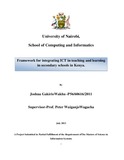| dc.description.abstract | The purpose of this study was to develop a framework for integrating ICT in teaching and learning
in secondary schools, by first investigating the challenges in integrating ICT in teaching and learning
in secondary schools. The study attempted to establish the effects of JCT literacy levels of teachers
and learners, technical and financial support and sustainability of ICT integration, the ICT
infrastructure available in schools to enable them integrate ICT in teaching and learning and the
perceptions of school managers and administrators and teachers in integrating ICT in teaching and
learning in secondary schools. For this study, an exploratory approach, using descriptive survey
design was used. The study was carried out in Kajiado County, Kenya. The study targeted a
population of fifty public secondary schools in Kajiado County. The researcher used purposive
sampling to select subjects for the survey. As such, only schools that benefited from the ESP-ICT
government funds for the financial year 201112012 were selected for survey. Kaj iado County is
divided into three zones: Kajiado North, Kajiado Central and Kajiado South. In each zone there were
five schools that benefited from the ESP-ICT funds from the Ministry of Education. These are the
schools that were sample for this survey.
The instruments used in the survey were questionnaires for teachers, head teachers, students and the
ICT designate teacher. An observation schedule for each of the fifteen schools was also used.
Collected data was then analyzed using descriptive and inferential statistics, where frequencies,
modes, percentages, correlations and cross-tabulation were the main techniques.
Major findings were that integration of JCTs in teaching and learning in secondary schools of
Kajiado County faces a lot of huddles. One of the huddles is the perception of curriculum
implementers, who find it hard to embrace ICTs in their teaching because of being contented with
the traditional ways of teaching, or because of perceived work load and length of syllabus. Teachers
also had a problem of lack of ICT skills. Head teachers and school managers did not have clear
policy on ICTs in their schools. Learners have very limited ICT skills to use the JCTs in and
learning. Another challenge is limited infrastructure. Internet access is a major challenge. Electricity
is a problem in some schools, and most schools do not have alternative sources of power in the event
of power blackouts. Some schools do not have computer laboratories. There was also lack of
technical and financial support. Based on the findings, we have proposed a decentralized countybased
framework for integrating ICTs in teaching and learning in secondary schools. Each county
education office should develop its own curriculum for capacity building teachers on ICT
integration. | en_US |


